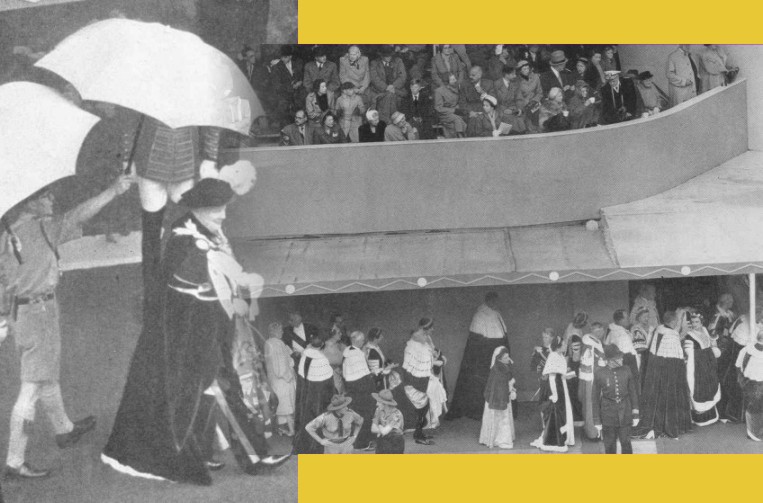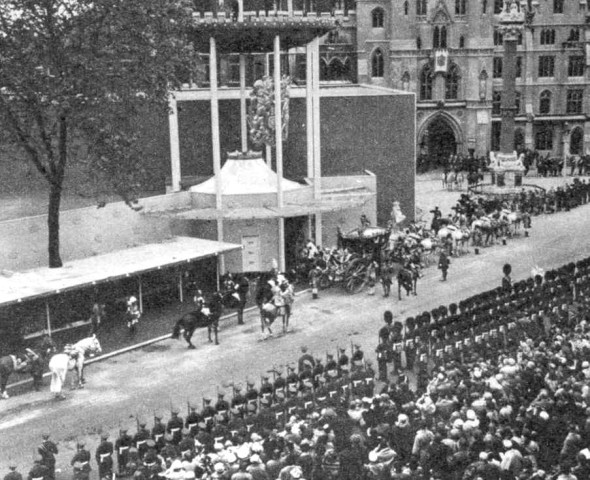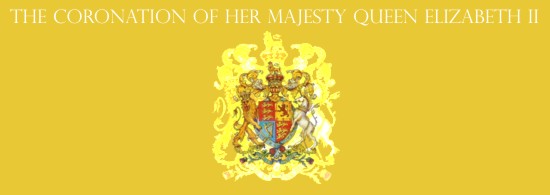


Not for once since the war had London seen all the banners, all those colours and all the joy that surrounded the Coronation Day. The only royal occasion in which a similar celebration had been seen was the wedding of the new Queen, then HRH Princess Elizabeth, heiress presumptive to the throne, to HRH the Duke of Edinburgh, born a Prince of Greece and Denmark. But then the pomp was reduced to the lowest limit of a grand royal event.
It was a long day, not only for those sleeping in the streets and waiting to catch a glimpse of the processions, to see their Queen, their beloved sovereign, but also for those 8.250 privileged guests who had the honour of seating in the galleries and in nave and quire of the most historic and remarkable temple of the Kingdom. For most guests, including the most important, the day began in the early hours of the morning, since they had to be seated inside the Abbey much before the beginning of the proceedings.

In the streets, thousands of soldiers began the preparations for what would be the most glorious military procession since the end of the British Empire, clearly a sign of how glorious that Empire had been. Military representation from all the corners of the Commonwealth of Nations and especially from the countries in which the Queen was still head of state had arrived in London in the previous weeks and thousands of soldiers had been installed in the underground barracks of London, which had last served during World War II. The colours of their uniforms and the different colours of their skins, showing the diversity of countries beforehand part of the Empire, now part of the Commonwealth, flooded the streets of London and began cheering the crowds up. Spirits were additionally buoyed by the news, announced to the crowds over loudspeakers, that a British expedition under Captain John Hunt had finally conquered Everest. Edmund Hillary, a New Zealander, had been the first to set foot on the summit with his Sherpa, Tenzing Norkhay.
Inside Westminster Abbey, the preparations began at 6 am, with the arrival of the officers who had been chosen to install the eight thousand, two hundred and fifty guests and guide the proceedings. One hour later, most guests, including the peers of the Kingdom, the members of the House of Commons, the Government, the Diplomatic Corps, the representatives of cultural, economic and other social organizations, had already arrives to the Abbey Church of St. Peter and were seated.

The Abbey was ready for a coronation. The closure during more than half a year had resulted in a plenty different look than the usual, with long galleries in the whole length of the nave, the Quire and also around the Altar, covered with blue velvet with gold embroidery representing the royal crown. As most churches, Westminster Abbey was built in form of cross. The Queen is in the United Kingdom the Head of the Anglican Church and thus her throne had to be placed right in the centre of that cross, the symbol of Christianity. Standing above a small dais, sober and elegant, impressively solitary, in crimson brocade, with the Queen’s state monogram and device embroidered in gold and blue, the new throne: EIIR, Elizabeth II Regina.
Looking up towards the altar, right in the line of the throne was St. Edward’s Chair also named Coronation Chair, containing the Stone of Scone, where all the British sovereigns were crowned, except for those who were not crowned at all. Facing the altar, to the left were the places for the Bishops of the Kingdom and to the right the Chair of Estate where the Queen would be seated during the first part of the ceremony. Above that chair, the gallery for the members of the British Royal Family, much lower than the other galleries. In the South Transept were the Peers of the Kingdom and in North Transept were the Peeresses, all wearing their impressive velvet copes and waiting to wear their aristocratic crowns. In the first line of the South Transept were the chairs for three of the four royal dukes, each bearing the respective coat of arms: Edinburgh, Gloucester and Kent. The fourth duke and former King Edward VIII, had declined the invitation or apparently been banned from attending.
See and read more about Westminster Abbey

At 8.30 am, the troops of the three services of the Armed Forces which would line the whole route for the coronation procession, from Buckingham Palace to the Abbey and then the much longer procession through London back to the Palace, began taking their places in the crowded streets. A quarter later, as Big Ben stroke out to announce the arrival of the first cortege to the Abbey, the lines were rectified. The first cortege had left Mansion House, in the City of London, towards the city of Westminster. The Lord Mayor of London, who usually travels alone in his golden and all-but-sober carriage, was this day accompanied by his wife as he left his residence in the City. His procession and arrival at Westminster were amongst the most cheered, given his popularity and the colours of the carriage.
At 8.55 am arrived the second cortege at the Abbey, a cortege of cars, carrying members of the British Royal Family but not senior royals, a cortege which had left the Palace just a fifteen minutes before. At 9 am, a cortege of eighty cars began arriving at the Abbey Church, carrying the representatives of foreign countries and members of foreign royal families. The magnificence of the royal uniforms contrasted with the soberness of the representatives of republics worldwide, who wore their dress coats with much more discreet decorations. As they entered to take their places in the Quire, the Abbey was progressively fulfilled with the grandeur of the day, given by the uniforms, the copes of the peers, the tiaras of the queens, princesses and peeresses.
At 9.30 am, one of the shortest and perhaps the most discreet cortege. The Speaker of the House of Commons, travelling with his wife in the oldest but also most sober carriage being used that day, left the Palace of Westminster towards the nearby Abbey. But the crowds were already being heard for another reason. Two of the most expected corteges were crossing London: in the first, perhaps the most colourful and uncommon, were travelling to the Abbey the Queen of Tonga and the Sultans of Zanzibar, of Johore, of Selangor, of Kalantan, of Perak, of Brunei and of Lahej. Surprisingly enough (after the colours of their dresses and uniforms) was the fact that despite the rain, which kept pouring in, the sovereigns were travelling in open landaus, braving the bad weather and being cheered for that fact. In the second cortege, which arrived at the Abbey at 9.40 am, Sir Winston Churchill, the beloved British Prime Minister and war hero was travelling to the coronation of his Queen. Wearing his uniform of Admiral Keeper of Cinque Ports and wearing his Garter, Sir Winston was travelling with his wife Lady Churchill, in the first of ten carriages, being followed in the others by the Prime Ministers of Northern Ireland, South Rhodesia, Ceylan, Pakistan, India, South Africa, New-Zealand, Australia and Canada.
See and read more about the guests of the Coronation

Meanwhile, the first grand cortege left Buckingham Palace towards the Abbey, through the fantastic cheers of the crowds and the glorious decorations of London. The Union Jack and the crown were everywhere. The Mall was flooded with banners and the whole route had seen special tribunes be built so that everyone – who could afford paying for a seat – was allowed to see every inch of the procession. The Household Cavalry in their shining uniforms went down The Mall preceding the three carriages of members of the Royal Family, which arrived at the Abbey at 10.14 am.
In the first carriage followed HRH the Princess Royal, HRH the Duchess of Gloucester and her two sons, Princes William and Richard, both wearing kilts. The Duchess wore a white dress with gold and silver embroidery and a long robe of purple velvet and trimmed with ermine. In the second carriage was HRH the Duchess of Kent, Princess Marina, born a Princess of Greece and Denmark, always the most royal and imposing of the royal ladies, with a magnificent embroidered white dress designed by Norman Hartnell and wearing the same jewels she had taken to the Coronation of her brother-in-law, King George VI, 17 years before. She too wore a long purple velvet robe. She was accompanied in the carriage by her sons HRH the Duke of Kent and HRH Prince Michael and by her daughter, HRH Princess Alexandra. In the third carriage followed HRH Princess Alice, Lady Patricia Ramsay, the Earl of Athlone and HRH Princess Marie Louise.
See and read more about some of the historic jewels worn at the Abbey

Simultaneously, a new cortege left the Palace, escorted once more by the Household Cavalry: in the magnificent Irish State Coach, the same in which she had travelled through London on the day of her husband’s funeral, HM Queen Elizabeth, the Queen Mother, wearing the circlet of her crown (bearing the brilliant and famous Koh-I-Noor diamond), with which she had been crowned in that same Abbey, 17 years before, and a long imposing robe. She was acclaimed as she went through London, on this that was a very special day for her, probably nostalgic too. She was accompanied by her younger daughter, HRH Princess Margaret, one of the most beautiful princesses of her time, who wore a scroll diamond tiara and also a robe in velvet trimmed with ermine.
In The Mall, the enthusiasm was at the highest. The Queen’s procession was being set in front of the Palace, including not only the only mounted band taking place in the procession, wearing their impressive golden tunics, but also the Household Cavalry, the Queen’s Bodyguard of the Yeomen of the Guard and several regiments of the Household Cavalry as well as members of the Canadian Mounted Escort. And as a band in the courtyard of the Palace stroke out the British National Anthem, the magnificence got finally to its highest as, pulled by eight grey horses, each having a page in a red and gold tunic by its side, the Gold State Coach got out of the Quadrangle. For the first time it was possible, on this of all days, to catch a glimpse of the Queen and her husband, HRH the Duke of Edinburgh. Behind the carriage, on horseback, were the Earl Mountbatten of Burma, Lord Louis, and HRH the Duke of Gloucester.

See and read more about the Queen’s Dress and Jewels
Slowly and graciously waving at the colossal crowds, the Queen looked wonderful although a bit refrained of expansive smiles and gestures. The Duke of Edinburgh looked delighted in his uniform of Admiral of the Fleet. Through the cheers, down The Mall, pass Trafalgar Square, the impressive and colourful cortege moved unhurriedly towards the Abbey, where it had to arrive, at the door of the Annex, which had specially been built for the Coronation in a modern design contrasting with the Abbey itself, when Big Ben was striking eleven. And so it did.
After all the bands, all the escorts, the Gold State Coach stopped in front of the Abbey as a band played the National Anthem which was spontaneously sung by the people and a fanfare was heard as the Duke of Edinburgh, followed by the Queen, left the carriage. The Royal Standard was raised in the mast over the Abbey. On her hands, Her Majesty carried an elegant bunch of white flowers and from her shoulders left her Parliamentary crimson robe trimmed with ermine. Everything was ready and the Coronation ceremony was about to begin.


